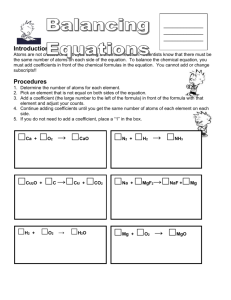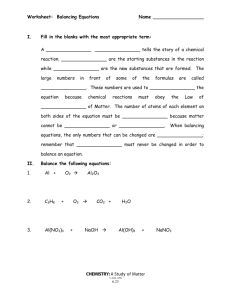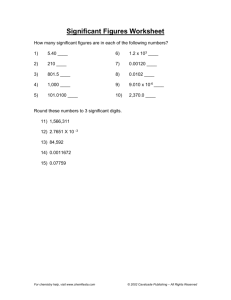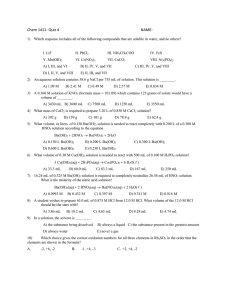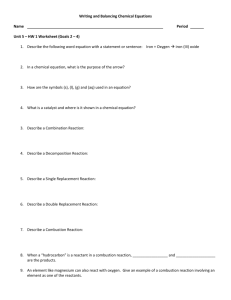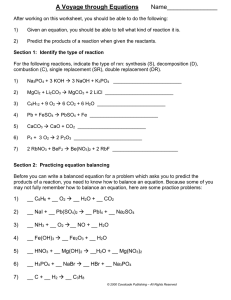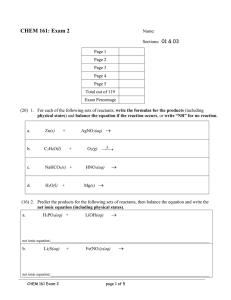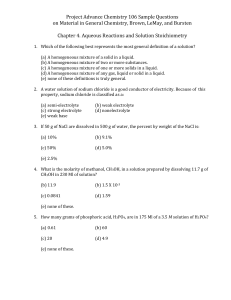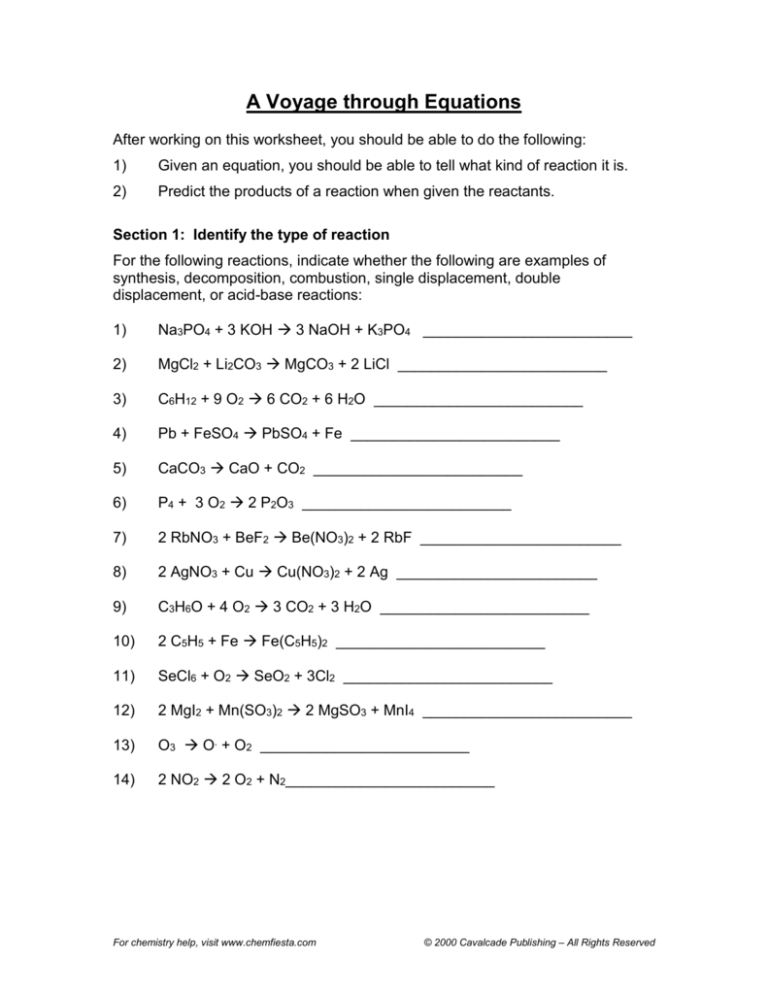
A Voyage through Equations
After working on this worksheet, you should be able to do the following:
1)
Given an equation, you should be able to tell what kind of reaction it is.
2)
Predict the products of a reaction when given the reactants.
Section 1: Identify the type of reaction
For the following reactions, indicate whether the following are examples of
synthesis, decomposition, combustion, single displacement, double
displacement, or acid-base reactions:
1)
Na3PO4 + 3 KOH 3 NaOH + K3PO4 _________________________
2)
MgCl2 + Li2CO3 MgCO3 + 2 LiCl _________________________
3)
C6H12 + 9 O2 6 CO2 + 6 H2O _________________________
4)
Pb + FeSO4 PbSO4 + Fe _________________________
5)
CaCO3 CaO + CO2 _________________________
6)
P4 + 3 O2 2 P2O3 _________________________
7)
2 RbNO3 + BeF2 Be(NO3)2 + 2 RbF ________________________
8)
2 AgNO3 + Cu Cu(NO3)2 + 2 Ag ________________________
9)
C3H6O + 4 O2 3 CO2 + 3 H2O _________________________
10)
2 C5H5 + Fe Fe(C5H5)2 _________________________
11)
SeCl6 + O2 SeO2 + 3Cl2 _________________________
12)
2 MgI2 + Mn(SO3)2 2 MgSO3 + MnI4 _________________________
13)
O3 O. + O2 _________________________
14)
2 NO2 2 O2 + N2_________________________
For chemistry help, visit www.chemfiesta.com
© 2000 Cavalcade Publishing – All Rights Reserved
Section 2: Practicing equation balancing
Before you can write a balanced equation for a problem which asks you to
predict the products of a reaction, you need to know how to balance an equation.
Because some of you may not fully remember how to balance an equation, here
are some practice problems:
1)
__ C6H6 + __ O2 __ H2O + __ CO2
2)
__ NaI + __ Pb(SO4)2 __ PbI4 + __ Na2SO4
3)
__ NH3 + __ O2 __ NO + __ H2O
4)
__ Fe(OH)3 __ Fe2O3 + __ H2O
5)
__ HNO3 + __ Mg(OH)2 __H2O + __ Mg(NO3)2
6)
__ H3PO4 + __ NaBr __ HBr + __ Na3PO4
7)
__ C + __ H2 __ C3H8
8)
__ CaO + __ MnI4 __ MnO2 + __ CaI2
9)
__ Fe2O3 + __ H2O __ Fe(OH)3
10)
__ C2H2 + __ H2 __ C2H6
11)
__ VF5 + __ HI __ V2I10 + __ HF
12)
__ OsO4 + __ PtCl4 __ PtO2 + __ OsCl8
13)
__ CF4 + __ Br2 __ CBr4 + __ F2
14)
__ Hg2I2 + __ O2 __ Hg2O + __ I2
15)
__ Y(NO3)2 + __ GaPO4 __ YPO4 + __ Ga(NO3)2
For chemistry help, visit www.chemfiesta.com
© 2000 Cavalcade Publishing – All Rights Reserved
Section 3: Predicting the products of chemical reactions
Predict the products of the following reactions:
1)
__ Ag + __CuSO4
Type:___________________________
2)
__ NaI + __ CaCl2
Type:___________________________
3)
__ O2 + __ H2
Type:___________________________
4)
__ HNO3 + __ Mn(OH)2
Type:___________________________
5)
__ AgNO2 + __ BaSO4
Type:___________________________
6)
__ HCN + __ CuSO4
Type:___________________________
7)
__ H2O + __ AgI
Type:___________________________
8)
__ HNO3 + __Fe(OH)3
Type:___________________________
9)
__ LiBr + __ Co(SO3)2
Type:___________________________
10)
__ LiNO3 + __Ag
Type:___________________________
For chemistry help, visit www.chemfiesta.com
© 2000 Cavalcade Publishing – All Rights Reserved
11)
__ N2 + __ O2
Type:___________________________
12)
__ H2CO3
Type:___________________________
13)
__ AlCl3 + __ Cs
Type:___________________________
14)
__ Al(NO3)3 + __ Ga
Type:___________________________
15)
__ H2SO4 + __ NH4OH
Type:___________________________
16)
__ CH3COOH + __ O2
Type:___________________________
17)
__ C4H8 + __ O2
Type:___________________________
18)
__ KCl + __ Mg(OH)2
Type:___________________________
19)
__ Zn + __ Au(NO2)2
Type:___________________________
20)
__ KOH + __ H2SO4
Type:___________________________
21)
__ BaS + __ PtCl2
Type:___________________________
22)
__ Na2O
Type:___________________________
For chemistry help, visit www.chemfiesta.com
© 2000 Cavalcade Publishing – All Rights Reserved


